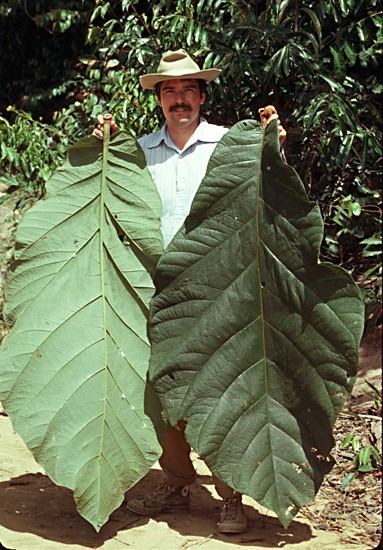
- James Zarucchi with some rather large leaves from the coccoloba plant. Photo courtesy of James Zarucchi
The 150-year-old Missouri Botanical Garden is known for undertaking ambitious and extraordinary projects. It's the oldest botanical garden in the United States, but it's also one of the country's most forward-thinking horticultural institutions. For a few years now it's been scanning its rare books collection and making every page available at Botanicus.com in a fully-searchable format that includes geotagging, tag clouds and lots of other hip high-tech tools. Scholars used to travel from all over the world to use their collection, but Botanicus allows anyone to page through these rare, valuable, and often quite fragile books from home, coffee and sticky doughnut in hand.
Its Web site-- Tropicos.com -- makes an extraordinary amount of plant taxonomy information available, along with photographs, illustrations and herbarium specimens, to any plant geek who wants to browse through it. They've got over a million plant names in the database, so there's considerable browsing to do.
And now they're working on a complete flora of North America. Jim Zarucchi, associate curator at Missouri Botanical Garden and manager of this project, is coming to Humboldt County on Nov. 7 to give a talk at the Humboldt Botanical Gardens Foundation's annual symposium. Details on that in a minute, but first, a little more about this project.
A "flora" is a book (or a database, or both) that describes all the plant species that occur in a particular region. It doesn't usually cover only native plants; a flora is meant to be broadly inclusive, describing all the plants that are well-established in the region it covers.
Even weeds. Even naturalized garden plants. Hybrids. Invasives. Whatever. Just -- you know -- all the plants that grow out there across this great nation of ours.
You're probably starting to get an idea of what an enormous project this is. The complete Flora of North America will run to 30 volumes, each around 700 pages in length, each costing about $95. They're halfway through at this point, and Zarucchi has been involved for 13 of the 15 volumes they've produced thus far.
"I'm like an orchestra conductor," he told me over the phone last week. "Up to this point just over 700 people have been involved. We expect it will be well over 1,000 people by the time we're finished. I'm supposed to know what's going on with authors, reviewers and editors all over North America."
The books are being printed in small runs of 2,000 each, and as you can imagine, they're mostly of interest to libraries and research institutions. "Take a volume like Bryophytes: Mosses, Part 1," he said. "That one maybe didn't sell as well. But the volume on orchids was very popular." About 46,000 copies of the various volumes have been sold so far.
Most of the contributors to this massive project are working not for the money, but for the glory. "For some of these botanists, this represents their entire life's work," Zarucchi said. "We have contributors who have spent 50 years researching willows or mosses, and now their work will finally be published in one place. This is everything for them."
An electronic version is being published as well, and while you can't yet carry the complete Flora of North America around on your iPhone, that day will surely come. Meanwhile, check out the project's website at fna.org. And if you're asking yourself, "Hey, wait a minute. What about all the other floras around the world? What's going on with the flora of Pakistan and Madagascar and Ecuador and Nepal? Is anyone working on that?" I have good news for you. It's all coming together at efloras.com. Get over there and geek out. I know you want to.
But first, make plans to come hear what Jim Zarucchi has to say. He's one of three speakers participating in this year's Humboldt Botanical Gardens Foundation Speakers Symposium. You'll also get to hear from Chris Carley, Supervisory Horticulturist at the U.S. National Arboretum, Washington, D.C., who will speak on "Lessons from the Gotelli Collection -- Let's Not Wait Until 2050 to Have this Conversation" This is the oldest and largest curated conifer collection in the United States. And the third person is -- well, me. After such intellectual and profound topics, I guess I'll be the comic relief. And in case you're wondering what the theme is this year -- past symposiums have all had a theme of some sort -- it's Humboldt County. All three of us have roots here of one kind or another. Jim Zarucchi graduated high school here, and Chris Carley is a former Trinidad resident and HBGF volunteer.
It's all happening at College of the Redwoods in the Forum Theater on Nov. 7 from 9 a.m. to 3 p.m. Registration is $25 for members, $15 for students, and $30 for non-members. That fee includes a lunch catered by Roy's, and something new: a tour of the botanical garden after lunch. Call HBGF at 442-5139 or go to hbgf.org to register. I'll see you there.
Comments